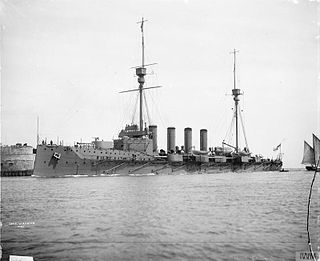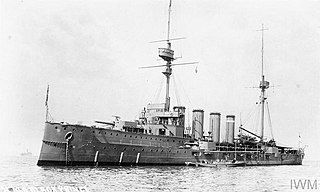
The heavy cruiser was a type of cruiser, a naval warship designed for long range and high speed, armed generally with naval guns of roughly 203 mm (8 inches) in calibre, whose design parameters were dictated by the Washington Naval Treaty of 1922 and the London Naval Treaty of 1930. The heavy cruiser is part of a lineage of ship design from 1915 through the early 1950s, although the term "heavy cruiser" only came into formal use in 1930. The heavy cruiser's immediate precursors were the light cruiser designs of the 1900s and 1910s, rather than the armoured cruisers of the years before 1905. When the armoured cruiser was supplanted by the battlecruiser, an intermediate ship type between this and the light cruiser was found to be needed—one larger and more powerful than the light cruisers of a potential enemy but not as large and expensive as the battlecruiser so as to be built in sufficient numbers to protect merchant ships and serve in a number of combat theatres.

HMS Warrior was a Warrior-class armoured cruiser built for the Royal Navy in the first decade of the 20th century. She was stationed in the Mediterranean when the First World War began and participated in the pursuit of the German battlecruiser SMS Goeben and light cruiser SMS Breslau. Warrior was transferred to the Grand Fleet in December 1914 and remained there for the rest of her career. She was heavily damaged during the Battle of Jutland in 1916, after which she withdrew and was later abandoned and sank in a rising sea.

The Courageous class consisted of three battlecruisers known as "large light cruisers" built for the Royal Navy during the First World War. The class was nominally designed to support the Baltic Project, a plan by Admiral of the Fleet Lord Fisher that was intended to land troops on the German Baltic Coast. Ships of this class were fast but very lightly armoured, with only a few heavy guns. They were given a shallow draught, in part to allow them to operate in the shallow waters of the Baltic but also reflecting experience gained earlier in the war. To maximize their speed, the Courageous-class battlecruisers were the first capital ships of the Royal Navy to use geared steam turbines and small-tube boilers.
The N3 class was a dreadnought battleship class designed for the Royal Navy after World War I, incorporating lessons learned from that conflict. They were similar in design to the G3-class battlecruiser, but had larger guns and thicker armour. They were never ordered due to signing of the Washington Naval Treaty in 1922, which limited the size and armament of battleships to 35,000 long tons (36,000 t) and guns no bigger than 16 inches (406 mm).

HMSBlack Prince was a Duke of Edinburgh-class armoured cruiser built for the Royal Navy in the early 1900s. She was stationed in the Mediterranean when the First World War began and participated in the pursuit of the German battlecruiser SMS Goeben and light cruiser SMS Breslau. After the German ships reached Ottoman waters, the ship was sent to the Red Sea in mid-August to protect troop convoys arriving from India and to search for German merchant ships. After capturing two ships, Black Prince was transferred to the Grand Fleet in December 1914. She was sunk on 1 June 1916 during the Battle of Jutland with the loss of all hands.

The BL 15-inch Mark I succeeded the BL 13.5-inch Mk V naval gun. It was the first British 15-inch (380 mm) gun design and the most widely used and longest lasting of any British designs, and arguably the most successful heavy gun ever developed by the Royal Navy. It was deployed on capital ships from 1915 until 1959 and was a key Royal Navy gun in both World Wars.

The BL 6-inch gun Mark VII was a British naval gun dating from 1899, which was mounted on a heavy travelling carriage in 1915 for British Army service to become one of the main heavy field guns in the First World War, and also served as one of the main coast defence guns throughout the British Empire until the 1950s.

The QF 6-inch 40 calibre naval gun (Quick-Firing) was used by many United Kingdom-built warships around the end of the 19th century and the start of the 20th century.

The QF 12 pounder 18 cwt gun (Quick-Firing) was a 3-inch high-velocity naval gun used to equip larger British warships such as battleships for defence against torpedo boats. 18 cwt referred to the weight of gun and breech, to differentiate the gun from others that also fired the "12 pound" shell.

The Vickers 10 inch naval gun was used on battleships and armoured cruisers built during the first decade of the 20th century. They were used as the Type 41 10-inch /45-caliber aboard the British-built semi-dreadnought Katori-class battleships and the natively-built Satsuma-class battleships of the Imperial Japanese Navy.

The BL 6-inch gun Marks II, III, IV and VI were the second and subsequent generations of British 6-inch rifled breechloading naval guns, designed by the Royal Gun Factory in the 1880s following the first 6-inch breechloader, the relatively unsuccessful BL 6-inch 80-pounder gun designed by Elswick Ordnance. They were originally designed to use the old gunpowder propellants but from the mid-1890s onwards were adapted to use the new cordite propellant. They were superseded on new warships by the QF 6-inch gun from 1891.

The QF 4-inch gun Mks I, II, III were early British QF (quick-firing) naval guns originating in 1895. They all had barrels of 40 calibres length.

The QF 4-inch gun Mk IV was the main gun on most Royal Navy and British Empire destroyers in World War I. It was introduced in 1911 as a faster-loading light gun successor to the BL 4 inch Mk VIII gun. Of the 1,141 produced, 939 were still available in 1939. Mk XII and Mk XXII variants armed many British interwar and World War II submarines.

The BL 4-inch Mark VIII naval gun was a British medium-velocity wire-wound naval gun introduced in 1908 as an anti-torpedo boat gun in smaller ships whose decks could not support the strain of the heavier and more powerful Mk VII gun.

The BL 6-inch Mark XI naval gun was a British 50 calibres high-velocity naval gun which was mounted as primary armament on cruisers and secondary armament on pre-dreadnought battleships from 1906 onwards.

The BL 12 inch Gun Mark X was a British 45-calibre naval gun which was mounted as primary armament on battleships and battlecruisers from 1906. It first appeared on HMS Dreadnought.

The BL 6-inch Mark XII naval gun was a British 45 calibre naval gun which was mounted as primary armament on light cruisers and secondary armament on dreadnought battleships commissioned in the period 1914–1926, and remained in service on many warships until the end of World War II.

The BL 4-inch Mk IX naval gun was a British medium-velocity naval gun introduced in 1917 as secondary armament on the Renown-class battlecruisers and Glorious-class "large light cruisers", but which served most notably as the main armament on Flower-class corvettes throughout World War II.

The BL 6-inch Mk XXII gun was a British high-velocity 6-inch 50-calibre wire-wound naval guns deployed on the Nelson-class battleships from the 1920s to 1945.
The J3 class battlecruiser was a design study conducted during the Royal Navy's 1921 Fleet modernization programme. As a follow-on to the Admiral-class battlecruiser, the J3 class incorporated all the lessons learned from the First World War, specifically the battle of Jutland. The design was seen as an improvement to the Admiral class by virtue of its heavier and improved armouring scheme, specifically the deck armour, although the offensive armament remained roughly the same. The design was superseded by the I3 and G3 battlecruiser designs, as both mounted a heavier main armament, and further improved the protection scheme, on roughly the same tonnage. The 1921 fleet program was cancelled due to signing of the Washington Naval Treaty in 1922, which limited the size and armament of battleships to 35,000 long tons (36,000 t) and no gun bigger than 16 inches (406 mm).




















